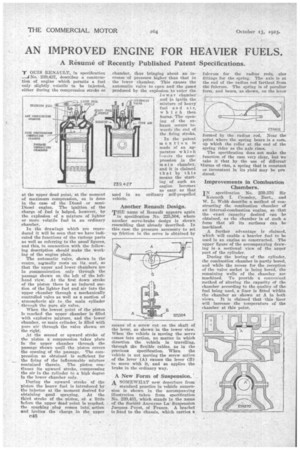AN IMPROVED ENGINE FOR HEAVIER FUELS.
Page 30

If you've noticed an error in this article please click here to report it so we can fix it.
A Résumé of Recently Published Patent Specifications.
T OD'S RENAULT, in specification —I No. 239,427, describes a construction of engine which permits a fuel only slightly volatile to be injected., either during the compression stroke or at the upper dead point, at the moment of maximum compression, as is done in the case of the Diesel or semiDiesel engine. The ignition of the charge of fuel is helped, however, by the explosion of a mixture of lighter or more volatile fuel in an ordinary chamber.
In the drawings which are reproduced it will be seen that we have indicated the functions of the various parts as well as referring to the usual figures, and this, in connection with the following description should make the working of the engine plain.
The automatic valve, shown in the centre, nurmally rests on its seat, so that the upper and lower chambers 'are in communication only through the passage shown on the left of the lefthand view. At the first down stroke of the piston there is an induced suction of the lighter fuel and air into the upper chamber through a mechanically controlled valve as well as a suction of atmospheric air to the main cylinder through the pure air valve.
When the lowest point of the piston Is reached the upper chamber is filled with explosive mixture, and the lower chamber, or main cylinder, is filled with pure air through the valve shown on the right.
At the second or upward stroke of the piston a compression takes place in the upper chamber through the passage shown until the piston covers the opening of the passage, The compression so obtained is sufficient for the firing of the inflammable mixture contained therein. The piston continues its upward stroke, compressing the air in the cylinder to a high degree In the lower chamber only.
During the upward stroke of the piston the heavy fuel is introduced by the injector at the moment desired for obtaining good spraying. At the third stroke of the piston, or a little before the upper dead point is reached, the sparking plug comes into: action and ignites the charge in the upper C40
chamber, thus bringing about an increase of pressure higher than that in the lower chamber. This causes the automatic valve to open and the gases produced by the explosion -to enter the lower chamber and to ignite the mixture of heavy fuel and air, which then burns. The opening of the exhaust occurs towards the end of the firing, stroke.
In the patent mention is made of an apparatus which lowers the compression in the main chamber, and it is claimed that by this means the starting of such an engine becomes as easy as that used in an ordinary self-propelled vehicle. 239,427
Another Renault Design.
THE name of Renault appears again in specification No. 225,504, where another servo-brake design is shown resembling that already described. In this case the pressure necessary to set up friction in the servo is obtained by means of a screw cut on the shaft of the lever, as shown in the lower view. When the vehicle is moving the servo comes into action, no matter in which direction the vehicle is travelling, through the flexible cables, as in the previous Specification. When the vehicle is not moving the screw action of the lever (A) causes the lever (B) to move with it, and so applies the brake in the ordinary way. •
A New Form of Suspension. A SOMEWHAT new departure from
standard practice in vehicle suspension is shown in the accompanying illustration taken from specification No. 239,431, which stands in the name of the Soci4t4, Anonyme La Suspension Jacques Royet, of France. A bracket is fixed to the chassis, which carries a fulcrum for the radius rods; also fittings for the. spring. The axle is at the end of the radius rod farthest from the fulcrum. The spring is of peculiar form, and bears, as shown, on the lever formed by the radius rod. Near the point where the spring bears is a cam, up which the roller at the end of the spring rides as the axle rises.
The specification does not make the function of the cam very clear, but we take it that by the use of different tforms of cam, a spring that is constant or inconstant in its yield may be pro duced.
Improvements in Combustion Chambers.
specifeation No. 239.370 Sir
Kenneth I. Crossley, Bart., and W. L. Webb describe a method of constructing the combustion chamber of an internal-combustion engine, so that the exact capacity desired can be obtained, as the chamber is of such a form that all its surfaces can be machined.
A further advantage is claimed, which will enable a heavier fuel to he used in an engine so constructed. The upper figure of the accompanying drawing is a sectional view of the upper part of the cylinder.
During the boring of the cylinder, the combustion chamber is partly bored, and while the recess for the reception of the valve secket is being bored, the remaining walls of the ehainber are machined. To provide a convenient method of altering the capacity of the chamber according to the quality of the fuel being used, a liner is fitted within the chamber as • shown at A in both views. It is claimed that this liner will increase the temperature of the chamber at this point.






























